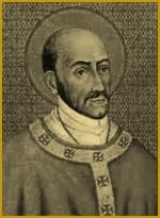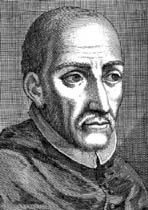
Turibius de Mongrovejo
Encyclopedia
Turibius of Mongrovejo (16 November 1538 – 23 March 1606) was a Spanish
judge of the court of the Spanish Inquisition
and missionary Archbishop of Lima from the Spanish nobility.
, Valladolid
, Spain, of noble family and highly educated, Turibius was named after another Spanish saint, Turibius of Astorga
. He became professor of law at the highly reputed University of Salamanca
. His learning and virtuous reputation led to his appointment as Grand Inquisitor of Spain by King Philip II
on the Court of the Inquisition at Granada
. During this time, he was ordained priest in 1578 and sent to Peru. Though not yet of ecclesiastical rank, Turibius was named Archbishop
of Lima
, Peru, in May 1579.
He arrived at Paita
, Peru, 600 miles (965.6 km) from Lima, on May 24, 1581. He began his mission work by travelling to Lima on foot, baptizing and teaching the natives. His favourite topic was: "Time is not our own, and we must give a strict account of it." Three times he traversed the 450000 square kilometres (173,746 sq mi) of his diocese, generally on foot, frequently defenceless and often alone; exposed to tempests, torrents, deserts, wild beasts, tropical heat, fevers and sometimes threats from hostile tribes; baptizing and confirming nearly one half million souls, among them St. Rose of Lima, and St. Martin de Porres.
He built roads, schoolhouses and chapels, many hospitals and convents, and at Lima, in 1591, founded the first seminary in the Western hemisphere. He inaugurated the first part of the third Lima Cathedral
on February 2, 1604.
Turibius assembled thirteen diocesan synods and three provincial councils. He was seen as a champion of the rights of the natives against the Spanish masters. "There was great opposition to Turibius from the governors of Peru whose authority he challenged," Elizabeth Hallam has written. "He learned local dialects so that he could communicate with–-and convert–-the native peoples, and he was a strong and effective champion of their rights."
Years before he died, he predicted the day and hour of his death. At Pacasmayo he contracted fever, but continued labouring to the last, arriving at Sana (or Saña) in a dying condition. Dragging himself to the sanctuary he received the Viaticum
, expiring shortly after on March 23, 1606.
 Turibius de Mogrovejo was beatified by Pope Innocent XI
Turibius de Mogrovejo was beatified by Pope Innocent XI
in the year 1679 and was later canonized by Pope Benedict XIII
in the year 1726. His liturgical feast was once celebrated on April 27, but currently on March 23. His cult was once confined mainly to South America
, but now more widespread because of his pioneering reforms.
Turibius is honored together with Martin de Porres
and Rosa de Lima with a feast day on the liturgical calendar of the Episcopal Church (USA)
on August 23.
Spain
Spain , officially the Kingdom of Spain languages]] under the European Charter for Regional or Minority Languages. In each of these, Spain's official name is as follows:;;;;;;), is a country and member state of the European Union located in southwestern Europe on the Iberian Peninsula...
judge of the court of the Spanish Inquisition
Spanish Inquisition
The Tribunal of the Holy Office of the Inquisition , commonly known as the Spanish Inquisition , was a tribunal established in 1480 by Catholic Monarchs Ferdinand II of Aragon and Isabella I of Castile. It was intended to maintain Catholic orthodoxy in their kingdoms, and to replace the Medieval...
and missionary Archbishop of Lima from the Spanish nobility.
Biography
Born in Mayorga de CamposMayorga, Spain
Mayorga de Campos is a town and municipality in Valladolid province, Spain, part of the autonomous community of Castile and León, Spain. Its name comes from the Leonese language, and there are several references to this village in the Middle Ages, in which Mayorga was a place in the Kingdom of...
, Valladolid
Valladolid (province)
Valladolid is a province of central/northwest Spain, in the central part of the autonomous community of Castile and León. It is bordered by the provinces of Zamora, León, Palencia, Burgos, Segovia, Ávila, and Salamanca....
, Spain, of noble family and highly educated, Turibius was named after another Spanish saint, Turibius of Astorga
Turibius of Astorga
Saint Turibius of Astorga was an archdeacon of Tuy and an early Bishop of Astorga. Turibius was a zealous maintainer of ecclesiastical discipline, and defender of the Nicene Christianity against the Galician heresy of Priscillianism, for which he received a supportive letter from Leo the Great,...
. He became professor of law at the highly reputed University of Salamanca
University of Salamanca
The University of Salamanca is a Spanish higher education institution, located in the town of Salamanca, west of Madrid. It was founded in 1134 and given the Royal charter of foundation by King Alfonso IX in 1218. It is the oldest founded university in Spain and the third oldest European...
. His learning and virtuous reputation led to his appointment as Grand Inquisitor of Spain by King Philip II
Philip II of Spain
Philip II was King of Spain, Portugal, Naples, Sicily, and, while married to Mary I, King of England and Ireland. He was lord of the Seventeen Provinces from 1556 until 1581, holding various titles for the individual territories such as duke or count....
on the Court of the Inquisition at Granada
Granada
Granada is a city and the capital of the province of Granada, in the autonomous community of Andalusia, Spain. Granada is located at the foot of the Sierra Nevada mountains, at the confluence of three rivers, the Beiro, the Darro and the Genil. It sits at an elevation of 738 metres above sea...
. During this time, he was ordained priest in 1578 and sent to Peru. Though not yet of ecclesiastical rank, Turibius was named Archbishop
Archbishop
An archbishop is a bishop of higher rank, but not of higher sacramental order above that of the three orders of deacon, priest , and bishop...
of Lima
Lima
Lima is the capital and the largest city of Peru. It is located in the valleys of the Chillón, Rímac and Lurín rivers, in the central part of the country, on a desert coast overlooking the Pacific Ocean. Together with the seaport of Callao, it forms a contiguous urban area known as the Lima...
, Peru, in May 1579.
He arrived at Paita
Paita
Paita is a city in northwestern Peru. It is the capital of the Paita Province which is in the Piura Region. It is a leading seaport in that region...
, Peru, 600 miles (965.6 km) from Lima, on May 24, 1581. He began his mission work by travelling to Lima on foot, baptizing and teaching the natives. His favourite topic was: "Time is not our own, and we must give a strict account of it." Three times he traversed the 450000 square kilometres (173,746 sq mi) of his diocese, generally on foot, frequently defenceless and often alone; exposed to tempests, torrents, deserts, wild beasts, tropical heat, fevers and sometimes threats from hostile tribes; baptizing and confirming nearly one half million souls, among them St. Rose of Lima, and St. Martin de Porres.
He built roads, schoolhouses and chapels, many hospitals and convents, and at Lima, in 1591, founded the first seminary in the Western hemisphere. He inaugurated the first part of the third Lima Cathedral
Lima Cathedral
The Basilica Cathedral of Lima is a Roman Catholic cathedral located in the Plaza Mayor of downtown Lima, Peru. Construction began in 1535, and the building has undergone many reconstructions and transformation since, however it still retains its colonial structure and facade...
on February 2, 1604.
Turibius assembled thirteen diocesan synods and three provincial councils. He was seen as a champion of the rights of the natives against the Spanish masters. "There was great opposition to Turibius from the governors of Peru whose authority he challenged," Elizabeth Hallam has written. "He learned local dialects so that he could communicate with–-and convert–-the native peoples, and he was a strong and effective champion of their rights."
Years before he died, he predicted the day and hour of his death. At Pacasmayo he contracted fever, but continued labouring to the last, arriving at Sana (or Saña) in a dying condition. Dragging himself to the sanctuary he received the Viaticum
Viaticum
Viaticum is a term used especially in the Roman Catholic Church for the Eucharist administered, with or without anointing of the sick, to a person who is dying, and is thus a part of the last rites...
, expiring shortly after on March 23, 1606.
Veneration

Pope Innocent XI
Blessed Pope Innocent XI , born Benedetto Odescalchi, was Pope from 1676 to 1689.-Early life:Benedetto Odescalchi was born at Como in 1611 , the son of a Como nobleman, Livio Odescalchi, and Paola Castelli Giovanelli from Gandino...
in the year 1679 and was later canonized by Pope Benedict XIII
Pope Benedict XIII
-Footnotes:...
in the year 1726. His liturgical feast was once celebrated on April 27, but currently on March 23. His cult was once confined mainly to South America
South America
South America is a continent situated in the Western Hemisphere, mostly in the Southern Hemisphere, with a relatively small portion in the Northern Hemisphere. The continent is also considered a subcontinent of the Americas. It is bordered on the west by the Pacific Ocean and on the north and east...
, but now more widespread because of his pioneering reforms.
Turibius is honored together with Martin de Porres
Martin de Porres
Martin de Porres was a lay brother of the Dominican Order who was beatified in 1837 by Pope Gregory XVI and canonized in 1962 by Pope John XXIII. He is the patron saint of mixed-race people and all those seeking interracial harmony.He was noted for work on behalf of the poor, establishing an...
and Rosa de Lima with a feast day on the liturgical calendar of the Episcopal Church (USA)
Calendar of saints (Episcopal Church in the United States of America)
The veneration of saints in the Episcopal Church is a continuation of an ancient tradition from the early Church which honors important people of the Christian faith. The usage of the term "saint" is similar to Roman Catholic and Orthodox traditions. Those in the Anglo-Catholic tradition may...
on August 23.

